The Canon AE-1 is a highly versatile 35mm SLR film camera‚ offering both full manual and shutter priority modes. Known for its user-friendly design‚ it features a built-in light meter‚ bright viewfinder‚ and compatibility with Canon FD-mount lenses. Its durability and compact size make it a favorite among photographers‚ from beginners to professionals. The AE-1 Program variant adds program mode‚ enhancing its functionality. This iconic camera balances manual control with ease of use‚ making it an excellent choice for learning photography fundamentals and creative expression.
Overview of the Canon AE-1 Camera
The Canon AE-1 is a 35mm SLR film camera introduced in 1976‚ designed to be user-friendly yet powerful. It combines manual control with convenience‚ offering both full manual and shutter-priority modes. The camera features a built-in light meter for accurate exposure readings and a bright viewfinder with a split-image prism for precise focusing. Its compact design and compatibility with Canon FD-mount lenses make it versatile. The AE-1 is renowned for its durability and accessibility‚ appealing to both professionals and beginners. Its manual controls allow photographers to adjust aperture‚ shutter speed‚ and ISO independently‚ while the shutter-priority mode offers semi-automatic functionality. This balance makes the AE-1 an excellent tool for learning photography fundamentals and creative expression.
Historical Significance and Popularity
The Canon AE-1‚ introduced in 1976‚ became an iconic camera in the history of photography. Its popularity stemmed from its innovative design‚ durability‚ and accessibility. As a bridge between professional and amateur photographers‚ it was marketed as an affordable‚ user-friendly SLR that still offered advanced manual controls. The AE-1 was widely adopted in photography schools‚ making it a cornerstone in teaching film photography. Its reliability and versatility earned it a loyal following‚ with many photographers still using it today. The camera’s enduring popularity has also led to a resurgence in film photography‚ solidifying its place as one of the most influential cameras of the 20th century.
Key Features of the Canon AE-1
The Canon AE-1 is renowned for its robust feature set‚ combining manual control with intuitive design. It offers full manual mode‚ allowing photographers to independently adjust shutter speed and aperture. Additionally‚ its shutter priority mode enables automatic aperture adjustment for convenience. The camera features a built-in light meter‚ providing precise exposure readings‚ and a bright viewfinder with a split-image prism for accurate focusing. The AE-1 supports a wide range of Canon FD-mount lenses‚ expanding creative possibilities. Its compact‚ durable build and straightforward controls make it accessible to both beginners and professionals. These features collectively ensure the AE-1 remains a versatile tool for mastering film photography techniques and achieving creative vision.
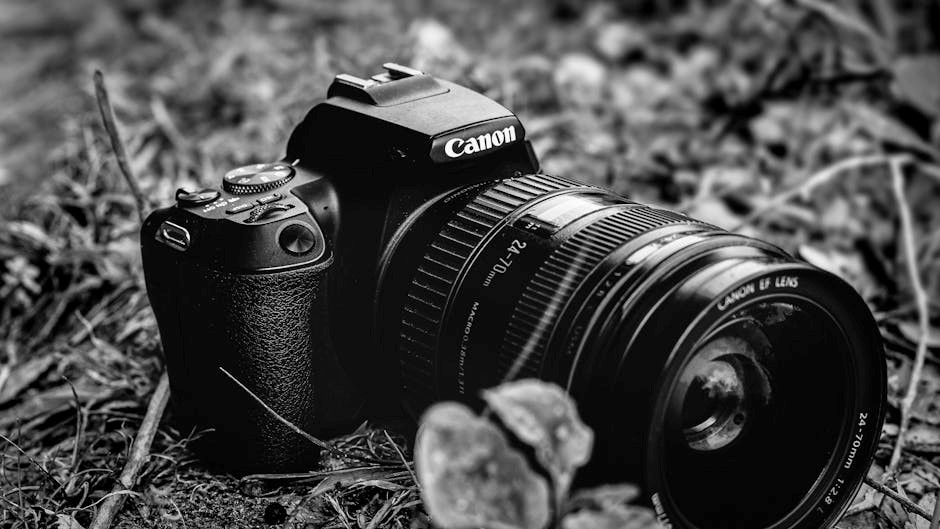
Understanding the Canon AE-1 Manual Modes

The Canon AE-1 offers full manual mode‚ allowing control over shutter speed‚ aperture‚ and ISO‚ as well as shutter priority mode for added flexibility in shooting scenarios.
What is Full Manual Mode?
In full manual mode on the Canon AE-1‚ photographers gain complete control over exposure settings‚ including shutter speed‚ aperture‚ and ISO sensitivity. This mode allows for precise adjustments to achieve the desired artistic effect. By setting both the aperture and shutter speed manually‚ users can master the exposure triangle‚ ensuring optimal results in various lighting conditions. The built-in light meter provides guidance‚ but the photographer retains full creative authority. This mode is ideal for experienced shooters seeking ultimate control and flexibility. It also serves as a valuable learning tool for beginners‚ helping them understand the fundamentals of exposure and develop their photographic skills. Full manual mode exemplifies the AE-1’s versatility and appeal.
Shutter Priority vs. Full Manual Mode
Shutter Priority mode on the Canon AE-1 allows photographers to set the shutter speed‚ while the camera automatically adjusts the aperture for proper exposure. This mode is ideal for capturing motion‚ as it provides control over freeze or blur effects. In contrast‚ Full Manual Mode grants complete control over both shutter speed and aperture‚ enabling precise adjustments for specific artistic or technical goals. Shutter Priority is more convenient for quick shooting‚ while Full Manual Mode offers greater creative flexibility. Both modes cater to different shooting styles‚ making the AE-1 adaptable for various photographic needs. Understanding these modes helps photographers leverage the camera’s capabilities effectively in diverse lighting conditions and creative scenarios.
Program Mode in the Canon AE-1 Program
The Canon AE-1 Program introduced the Program mode‚ allowing the camera to automatically set both shutter speed and aperture for optimal exposure. This mode is designed for ease of use‚ making it ideal for beginners or quick shooting situations. Unlike the original AE-1‚ which only offered shutter-priority and full manual modes‚ the Program mode simplifies photography by handling exposure settings automatically. This feature is particularly useful for those who want to focus on composition and subject rather than technical adjustments. While it offers convenience‚ experienced photographers may prefer the creative control of manual modes. The Program mode enhances the AE-1’s versatility‚ catering to a broader range of users and shooting styles.

Exposure Control in the Canon AE-1
The Canon AE-1 offers precise manual control over shutter speeds and aperture settings‚ complemented by a built-in light meter for accurate exposure readings. The viewfinder provides clear feedback for adjusting settings to achieve desired results‚ ensuring optimal image capture in various lighting conditions.
Manual Shutter Speeds and Aperture Control
The Canon AE-1 allows photographers to manually set both shutter speeds and aperture‚ providing full creative control over exposure. Shutter speeds range from 1/1000th of a second to 30 seconds‚ plus a bulb mode for extended exposures. Aperture control is managed through compatible Canon FD-mount lenses‚ enabling precise adjustments to suit various lighting conditions. This dual control system empowers users to achieve their desired visual effects‚ whether capturing fast-moving subjects or creating artistic depth of field. The manual controls are intuitive‚ making it easy for photographers to experiment and refine their techniques for optimal image quality.
Built-in Light Meter and Its Functionality
Built-in Light Meter and Its Functionality
The Canon AE-1 features a built-in light meter‚ essential for accurate exposure control. This through-the-lens (TTL) meter measures light directly‚ ensuring precise readings. In manual mode‚ the meter guides adjustments to shutter speed and aperture for optimal exposure. A needle in the viewfinder indicates meter readings‚ helping photographers balance settings. The meter also functions in shutter priority mode‚ automatically adjusting aperture for correct exposure. This tool simplifies the process for beginners while offering professionals reliable feedback. Its functionality enhances the AE-1’s usability‚ making it a versatile choice for photographers seeking control and precision in their work.
Using the Viewfinder for Accurate Exposure
The Canon AE-1’s viewfinder is a crucial tool for achieving accurate exposure. It features a bright‚ clear display with a built-in light meter needle‚ providing real-time feedback on your settings. When in manual mode‚ the needle indicates whether your exposure is under‚ over‚ or correctly set. The viewfinder also displays the selected aperture and shutter speed‚ allowing you to make precise adjustments. By pressing the shutter button halfway‚ the meter activates‚ giving you an instant reading. This system helps photographers‚ especially beginners‚ understand exposure dynamics without relying on external LCD screens. The viewfinder’s simplicity and functionality make it an essential part of the AE-1’s design‚ ensuring intuitive and effective control over your photography.

Focusing and Metering
The Canon AE-1 features a bright viewfinder with a split-image prism for precise focusing and manual focusing techniques. It also offers advanced metering modes for accurate exposures.
Bright Viewfinder with Split-Image Prism
The Canon AE-1 features a bright viewfinder with a split-image prism‚ enabling precise manual focusing. This prism divides the image into two parts‚ aligning when focus is achieved. The viewfinder’s clarity and brightness enhance visibility‚ making it easier to compose shots. The split-image prism is particularly useful for manual focusing‚ as it provides a clear visual cue for sharp focus. This feature is especially beneficial in full manual mode‚ where precise control over focus and exposure is essential. The viewfinder does not display meter readings‚ keeping the interface clean and uncluttered‚ allowing photographers to concentrate on framing and focusing without distractions. This design makes the AE-1 ideal for photographers who prefer a straightforward‚ hands-on approach to their craft.
Manual Focusing Techniques
Manual focusing with the Canon AE-1 is straightforward and precise‚ thanks to its intuitive design. The camera features a split-image prism in the viewfinder‚ which helps achieve sharp focus by aligning two halves of the image. Additionally‚ the microprism collar provides a textured focus area for quick and accurate adjustments. Photographers can use these tools to ensure their subject is perfectly in focus‚ even in challenging lighting conditions. The AE-1’s manual focus design encourages deliberate and thoughtful shooting‚ allowing for full creative control. While modern cameras rely on autofocus‚ the AE-1’s manual system remains effective and rewarding‚ making it a great tool for honing focusing skills and understanding the fundamentals of photography.
Advanced Metering Modes
The Canon AE-1 features a built-in light meter that provides accurate exposure readings‚ enabling precise control over your shots. While it doesn’t offer multiple advanced metering modes like modern cameras‚ its center-weighted metering system is reliable for most lighting conditions. This system emphasizes the central part of the frame‚ making it effective for balanced exposures. For more challenging scenarios‚ the AE-1’s manual controls allow for adjustments based on the meter’s readings. The camera’s simplicity and effectiveness make it a great tool for photographers who value understanding and controlling exposure manually. Its metering system‚ combined with full manual capabilities‚ ensures that you can achieve the desired results with precision and creativity.
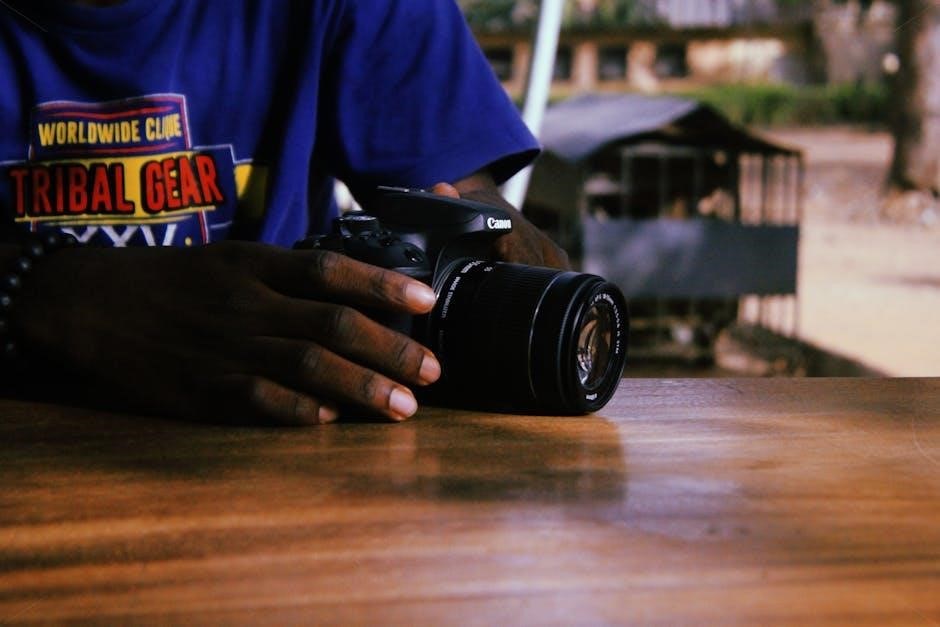
Additional Features and Accessories
The Canon AE-1 supports a wide range of Canon FD-mount lenses‚ offering versatility for various shooting needs. Accessories like remote controls enhance functionality‚ while the AE-1 Program version adds program mode for advanced shooting.
Compatible Lenses for the Canon AE-1
The Canon AE-1 is compatible with Canon FD-mount lenses‚ offering a wide range of options for photographers. Popular choices include the 50mm f/1.8‚ 35mm f/2‚ and 70-200mm zoom. These lenses provide excellent optical quality and versatility for various photography styles. The FD-mount system ensures compatibility with both prime and zoom lenses‚ allowing for creative flexibility. Additionally‚ third-party lenses from brands like Vivitar and Tokina are also available‚ providing budget-friendly alternatives. The AE-1’s lens compatibility makes it a versatile tool for photographers seeking to experiment with different focal lengths and aperture settings. This wide range of options enhances the camera’s appeal for both beginners and advanced users.
Remote Control and Other Accessories
The Canon AE-1 can be enhanced with various accessories to improve functionality. A popular addition is the Opteka RC-4 Wireless Remote Control‚ which allows photographers to trigger the shutter wirelessly‚ reducing camera shake. Other accessories include lens filters‚ such as UV and polarizing filters‚ which protect the lens and enhance image quality. External flash units also complement the AE-1‚ offering additional lighting control. These accessories expand the camera’s versatility‚ making it suitable for diverse photography styles. Whether using the remote for precise shots or filters for creative effects‚ these tools enhance the AE-1’s performance‚ catering to both casual and professional photographers seeking to optimize their shooting experience.
Canon AE-1 Program vs. Original AE-1
The Canon AE-1 Program introduces Program mode‚ unlike the original AE-1‚ which offers only shutter-priority and full manual modes. This addition provides greater versatility‚ allowing users to shoot in fully automatic settings. Both models share the same manual capabilities‚ but the Program version simplifies operation for beginners. The original AE-1 is favored for its straightforward design‚ while the Program variant appeals to those seeking more shooting options. Both cameras maintain the classic AE-1 build quality and compatibility with Canon FD-mount lenses. The Program model is often preferred for its convenience‚ while the original remains a staple for purists who prefer manual control. This distinction makes both cameras excellent choices‚ catering to different user preferences and skill levels.
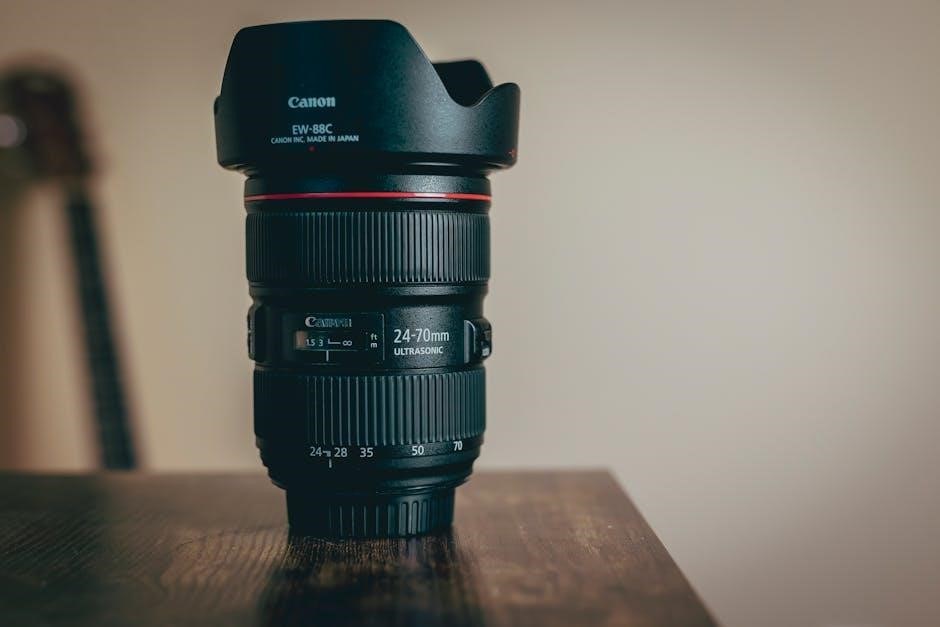
Maintenance and Troubleshooting
Regular cleaning of the viewfinder and lens ensures optimal performance. Lubricate mechanical parts periodically to prevent wear. Check the built-in light meter for accuracy. Address common issues like stuck shutters or aperture malfunctions promptly. For complex repairs‚ seek professional services to maintain the camera’s functionality and longevity.
Cleaning and Maintaining the Canon AE-1
Regular cleaning and maintenance are essential to ensure the Canon AE-1 operates smoothly. Use a soft‚ dry cloth to wipe down the exterior and remove dust. For the viewfinder and lens‚ employ a microfiber cloth and gentle cleaning solutions to prevent scratches. Avoid harsh chemicals‚ as they may damage the camera’s finish. Clean the mirror and focal plane screen with a brush or compressed air to eliminate debris. Store the camera in a dry‚ cool place to prevent moisture damage. Lubricate mechanical parts periodically to maintain functionality. Handle the camera with care to avoid physical damage. Regular maintenance ensures longevity and optimal performance.
Common Issues and Solutions
Users of the Canon AE-1 may encounter several common issues. One frequent problem is inaccurate meter readings‚ often caused by old or depleted batteries. Replacing the batteries with fresh ones typically resolves this. Another issue is jammed shutters‚ which can occur due to dirt or wear. Cleaning the shutter mechanism with compressed air or consulting a professional can fix this. Additionally‚ light leaks may develop over time‚ especially around the camera’s seals. Replacing worn-out light seals can prevent this. For mirror issues‚ ensuring proper lubrication and avoiding forced movements are recommended. Addressing these issues promptly helps maintain the camera’s performance and extends its lifespan for continued use.
Where to Find Repair Services
For Canon AE-1 repair services‚ contact Canon’s customer support at 800-227-6433 for assistance or guidance. Local camera shops and authorized Canon service centers are reliable options. Online platforms like eBay and specialized repair shops also offer services. Additionally‚ Canon’s official website can direct you to authorized repair centers. Photography forums and communities are great sources for recommendations. When choosing a repair service‚ check reviews and ask for referrals to ensure quality work. Regular maintenance and timely repairs will help extend the life of your Canon AE-1 and maintain its optical performance and reliability. Always opt for genuine parts to ensure longevity and consider DIY cleaning for minor issues to prevent major repairs.
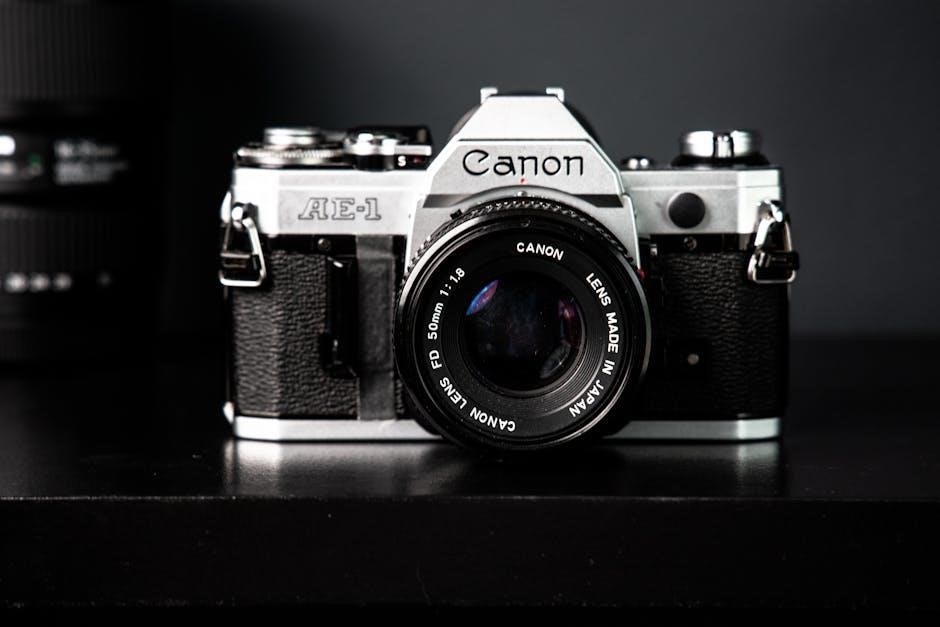
Canon AE-1 for Beginners
The Canon AE-1 is ideal for beginners due to its intuitive design and manual controls. It allows learning shutter speed‚ aperture‚ and ISO adjustments in a straightforward manner. The built-in light meter and bright viewfinder simplify understanding exposure‚ making it a perfect tool for mastering photography fundamentals. Its compatibility with various lenses and ease of use ensure a smooth transition from automatic to manual shooting‚ fostering creative growth and technical skills for new photographers. The AE-1’s durability and affordability further enhance its appeal as a starter camera. It’s a timeless choice for those eager to explore film photography and develop their craft.
Why the AE-1 is Ideal for Learning Photography
The Canon AE-1 is an excellent choice for beginners due to its intuitive design and manual controls‚ which provide hands-on learning of photography fundamentals. Its full manual mode allows users to understand and control shutter speed‚ aperture‚ and ISO‚ while the built-in light meter offers immediate feedback for mastering exposure. The bright viewfinder with a split-image prism simplifies focusing‚ enabling learners to concentrate on composition and technique. Additionally‚ the AE-1’s compatibility with a wide range of Canon FD-mount lenses encourages experimentation with different focal lengths and styles. Its durability‚ affordability‚ and ease of use make it a timeless tool for photographers looking to develop their skills in film photography.
Tips for Shooting in Full Manual Mode
Shooting in full manual mode with the Canon AE-1 offers complete control over your photography. Start by setting your desired shutter speed and aperture‚ then adjust the ISO based on lighting conditions. Use the built-in light meter to guide your exposure settings‚ ensuring balanced results. Bracket your shots to experiment with different exposures. Begin with familiar settings‚ such as f/8 and 1/125s‚ and adjust as needed. Practice focusing manually using the bright viewfinder and split-image prism for sharp results. Experiment with creative techniques like long exposures or shallow depth of field. Always review your photos to refine your settings and techniques. This hands-on approach helps master the fundamentals of photography effectively.
Resources for Mastering the AE-1
Mastering the Canon AE-1 is made easier with a variety of resources. Start with the official Canon AE-1 manual‚ which provides detailed instructions and diagrams. Online tutorials and YouTube channels offer step-by-step guides for understanding manual modes and exposure control. Photography forums and communities‚ such as Reddit’s r/photography‚ are great for asking questions and sharing experiences. Additionally‚ local photography workshops can provide hands-on learning opportunities. Experimenting with different techniques and regularly practicing will help you become proficient. Utilize these resources to unlock the full potential of your Canon AE-1 and enhance your photography skills. Consistent practice and exploration will make you a master of this iconic camera.
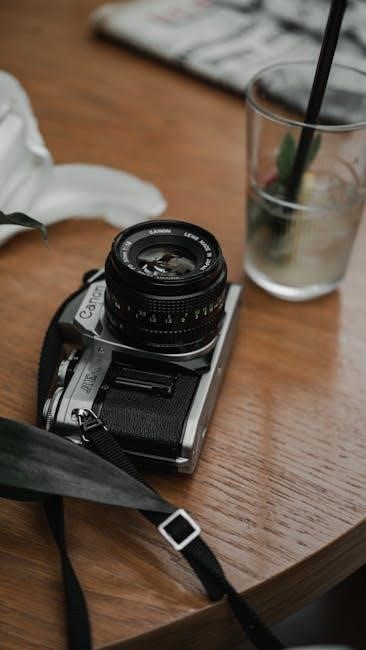
Canon AE-1 Full Manual and User Experience
The Canon AE-1 offers full manual control‚ allowing photographers to adjust shutter speed‚ aperture‚ and ISO for precise creative control. Its intuitive design makes manual shooting accessible and enjoyable‚ especially for beginners learning the fundamentals of photography.
Navigating the Camera’s Controls
The Canon AE-1 features intuitive controls designed for easy operation. The shutter speed dial‚ located on top‚ allows quick adjustments from 1/1000th of a second to bulb mode. The aperture is controlled via the lens ring‚ while the ISO is set using the dial on the bottom‚ though it doesn’t directly affect the camera’s metering. The viewfinder displays a built-in light meter needle‚ LED indicators for programmed modes‚ and a battery check. Focusing is done manually using the split-image prism‚ ensuring precise control. The film advance lever and rewind knob are ergonomically placed‚ making the camera easy to handle. Additional features like self-timer and multiple exposures switch are conveniently located‚ enhancing the user experience.
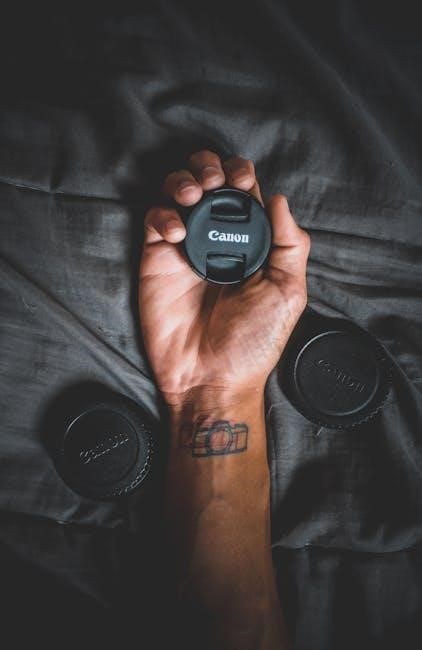
Understanding the Exposure Compensation
Exposure compensation on the Canon AE-1 allows photographers to adjust settings for optimal image results. The camera’s built-in light meter provides accurate readings‚ guiding manual adjustments of aperture‚ shutter speed‚ and ISO. In full manual mode‚ users can compensate by adjusting these settings based on the meter’s needle‚ ensuring balanced exposure. The viewfinder displays an LED indicator for programmed modes‚ offering additional guidance. The AE-1’s design emphasizes intuitive control‚ enabling precise exposure adjustments. This feature is essential for achieving desired effects‚ whether capturing bright highlights or rich shadows. Understanding exposure compensation enhances creative control‚ making the AE-1 a powerful tool for both beginners and experienced photographers.
Customizing Your Shooting Experience
Customizing your shooting experience with the Canon AE-1 is straightforward and intuitive. The camera offers interchangeable lenses‚ allowing photographers to adapt to various shooting scenarios. Accessories like remote controls enable hands-free operation‚ reducing camera shake and enhancing creativity. The AE-1 Program’s additional modes provide flexibility‚ catering to different photography styles. Users can also experiment with different film stocks‚ further personalizing their results. The camera’s ergonomic design and accessible controls make it easy to tailor settings to individual preferences. Whether shooting in manual or program modes‚ the AE-1 provides the tools to craft unique and personalized photographs‚ ensuring a tailored approach to every shot.
The Canon AE-1 remains a timeless classic‚ offering full manual capabilities and versatility for photographers of all levels. Its enduring legacy in film photography is undeniable.
Final Thoughts on the Canon AE-1
The Canon AE-1 is a legendary camera that has left an indelible mark on film photography. Its ability to function in full manual mode‚ combined with its durability and intuitive design‚ makes it a favorite among both professionals and beginners. The camera’s versatility allows users to master fundamental photography skills while exploring creative possibilities. Its built-in light meter and bright viewfinder enhance precision‚ ensuring accurate exposures. The AE-1’s enduring popularity is a testament to its timeless design and functionality. Whether you’re shooting in manual‚ program‚ or shutter priority mode‚ the AE-1 delivers exceptional results‚ solidifying its place as one of the most iconic film cameras ever produced.
Legacy and Impact on Film Photography
The Canon AE-1 has left an indelible mark on film photography‚ becoming a cultural icon and a cornerstone of photographic education. Introduced in the 1970s‚ it democratized advanced photography by offering manual controls and a built-in light meter at an accessible price; Its popularity soared among professionals and hobbyists alike‚ making it one of the best-selling film cameras in history. The AE-1’s intuitive design and durability helped countless photographers hone their skills‚ earning it a reputation as an ideal teaching tool. Today‚ it remains a sought-after collector’s item and a symbol of the golden era of film photography‚ inspiring new generations to explore the art of analog imaging.

